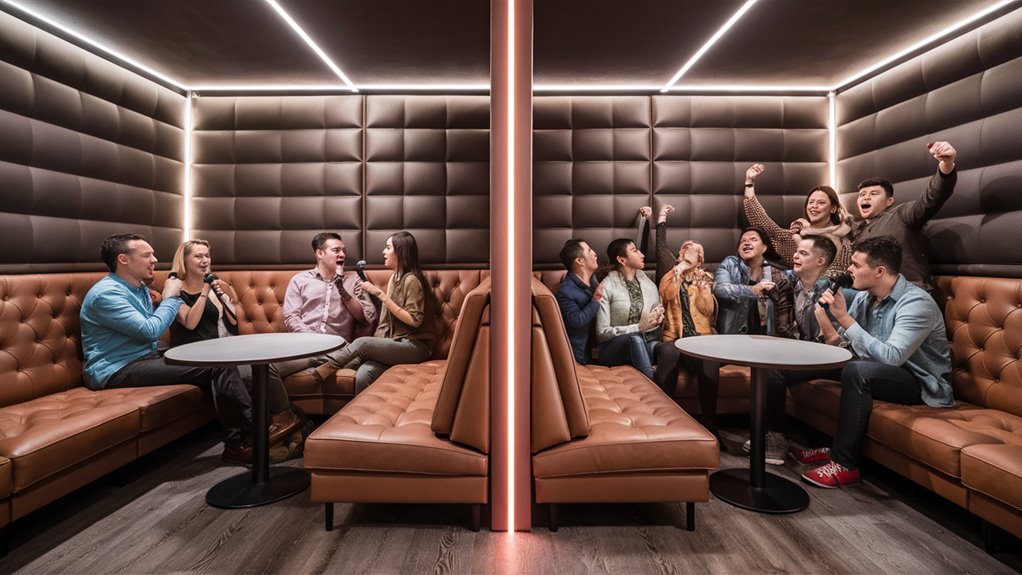How to Choose the Best Karaoke Room for Your Group
Inside every karaoke room lies the potential for an epic night out – but only if you know these crucial selection tips.

How to Pick the Best Karaoke Spot for Your Friends

Room Size and the Right Fit
When picking a karaoke spot, ensure the size fits well for a comfortable time. Plan for about 15-20 square feet per person:
- Small teams (4-6 people): 100 square-foot area
- Medium teams (8-12 people): 200 square-foot area
- Large teams (15-20 people): 300+ square-foot area
Must-Have Sound Gear
The best karaoke rooms should have: https://getwakefield.com/
- Top-notch speakers for sharp sound
- Microphones with no echo
- A big song list (at least 20,000 songs)
- HD screens to see lyrics well
- Easy song picking tools
Cost Factors
Consider these cost factors:
- Busy vs. quiet times
- Deals for groups
- Minimum booking time
- Minimum spend on drinks and snacks
- Extra gear fees
Room Comfort
For a pleasant time, ensure the room has:
- Cool air
- Cozy seats
- Soundproof walls
- Good air flow
- Call buttons for help
- Choices for food and drinks
Booking Details
Consider these booking points:
- Book early needs
- Cancellation rules
- Weekend spots
- Holiday costs
- Group size changes
How Big Should Karaoke Rooms Be
Why Size Is Key
A room with 15-20 square feet per person ensures a comfortable and safe setting.
This rule keeps everyone safe and having fun.
Small Room Details
Small karaoke spaces (around 100 square feet) fit 4-6 people with:
- Cozy seats
- A spot to sing
- Necessary sound gear
- Good screen view
Medium Room Needs
Medium karaoke spots at 200 square feet hold 8-12 people with:
- Various seat choices
- Better spots to watch
- More stage space
- Top-line sound gear
Large Room Setups
The best karaoke areas of 300+ square feet can fit 15-20 people with:
- Pro sound tech
- Many microphones
- Perfect spots to watch
- Big dance spots
Key Layout Needs
Important layout parts include:
- Seat setups
- Clear ways out
- Enough stage space
- Check how many fit
- Enough room between singing and watching spots
Sticking to limits avoids extra costs and keeps it safe.
Sound Checks
How to Test Sound Quality
Testing the Microphone
Sound tests start with mic checks for:
- Clear sound and less echo
- Quick sound fixes
- Issues with signals
Change gear if you note any static, delays, or problems.
Testing Speakers
Sound tests check each speaker for:
- Bass setup
- Clear high tones
- Right sound levels
Test speakers with different sound levels and known songs.
Two-way sound controls keep a good music-to-voice mix, key for good karaoke.
Needed Gear Parts
Modern sound systems should have:
- Digital audio tech
- Advanced mixing tools
- Echo cut-down feature
- Easy-to-use controls
Check past fixes and tech updates.
Top spots always check their sound for best output.
Ask about regular care and new gear.
Songs and Updates
Handling Songs and New Adds

Pro Song Picking Tools
A huge digital song list is key for any top karaoke place.
Brands like TouchTunes, SoundChoice, and Kumyoung offer pro software with lots of song picks.
These systems mix old favorites with new hits well.
Song Count and Mix
Modern karaoke spots should have at least 20,000 songs from different styles:
- Pop and Top 40
- Old rock
- R&B and soul
- Country
- World hits
- Songs in many languages
Easy Song Reach
Online song lists and apps make it better by letting:
- Set playlists early
- Pick songs on the move
- Look for songs in many languages
- Work across different platforms
- Get new songs often
Keeping Song Quality
Good places always check song quality by:
- Looking for bad files
- Making sure lyrics are right
- Updating the catalog every month
- Helping songs in many languages
- Adding songs people ask for
These steps keep music and choices top-notch, keeping the place known in karaoke fun.
Prices and Offers
Karaoke Room Prices and Savings
Main Price Info
The hourly rate sets the price for karaoke rooms, changing by room size, busy hours, and picked days.
Booking in quiet times, like weekday afternoons, often saves you money.
Room size makes prices go up or down, with small rooms costing less than big ones for large teams.
Packs and Extras
Full packs often give great worth, adding drinks, food, more song picks, and longer booking times.
Work out total cost per person based on:
- Minimum needed money
- Drink deals
- Snack picks
- Extra gear fees
- Service fees
Special Deals and Savings
Smart booking can cut costs through:
- Happy hour deals
- Early bird rates
- Longer time discounts
- Rates for groups
- Offers for members
- Cuts for students
- Packs for businesses
Make sure pack parts have microphones, song systems, and service fees to dodge sudden costs.
Long stays often get better rates, mainly for times longer than three hours.
Key Room Features
Karaoke Room Must-Haves
The Need for Comfort
Modern karaoke places focus on comfy features that make singing better.
Premium seats, like soft, well-made couches, fit groups and give plenty of room.
Climate setups keep the air just right for long sing-alongs, making sure all stay comfy.
Sound Quality and Setup
Pro sound gear is key for a great karaoke time. How to Plan the Best Karaoke Party for Your Birthday
Soundproof walls and smart design make sure music spreads evenly and clearly.
Good mic setups boost sound clearness, while well-placed speakers spread sound well.
Extras and More
Priority spots for drinks and easy help call buttons are present.
Lights that move with the music light up the space.
Many HD screens let all see lyrics well from any spot.
More perks like gear, power spots, and easy-to-get-to storage add to a top karaoke time.




